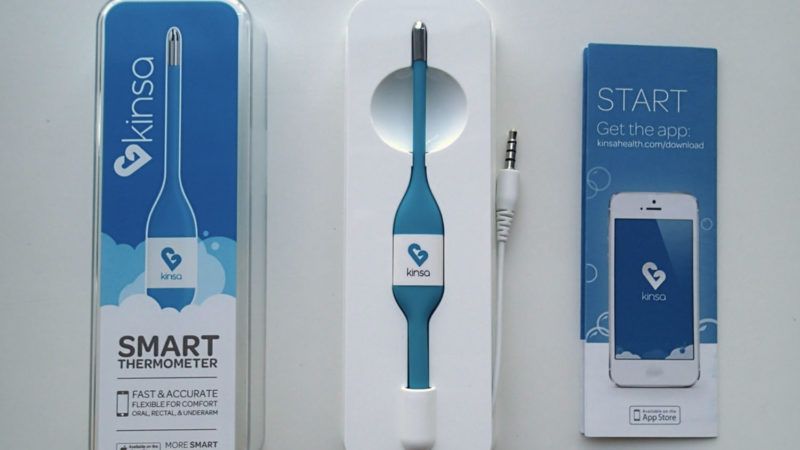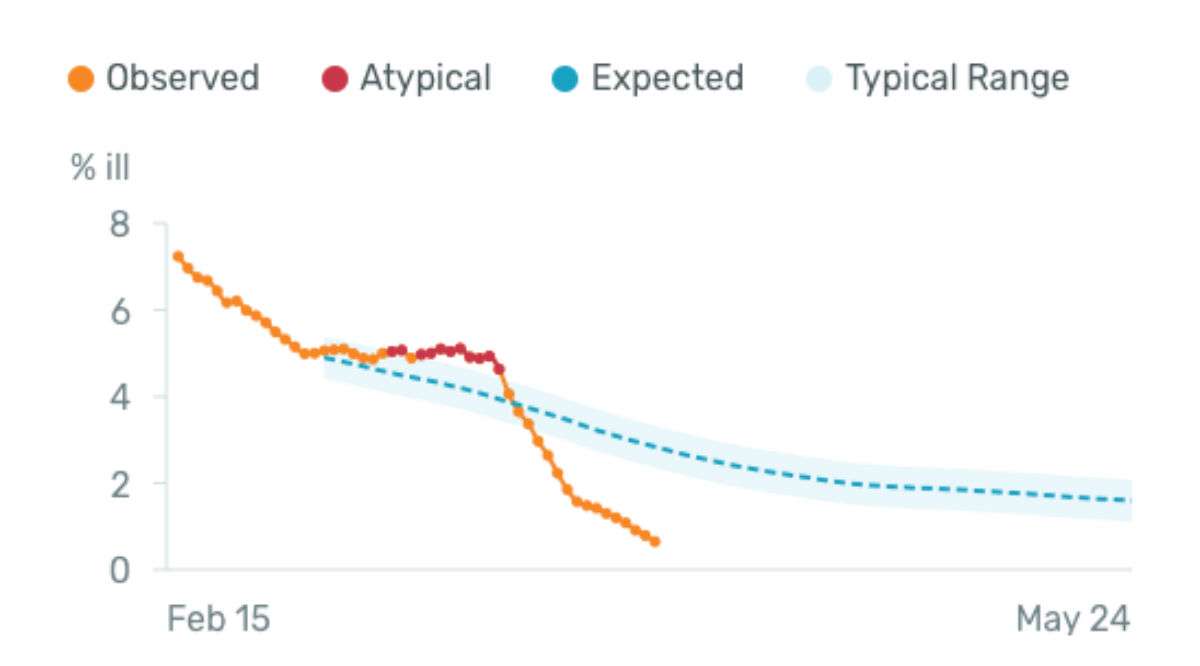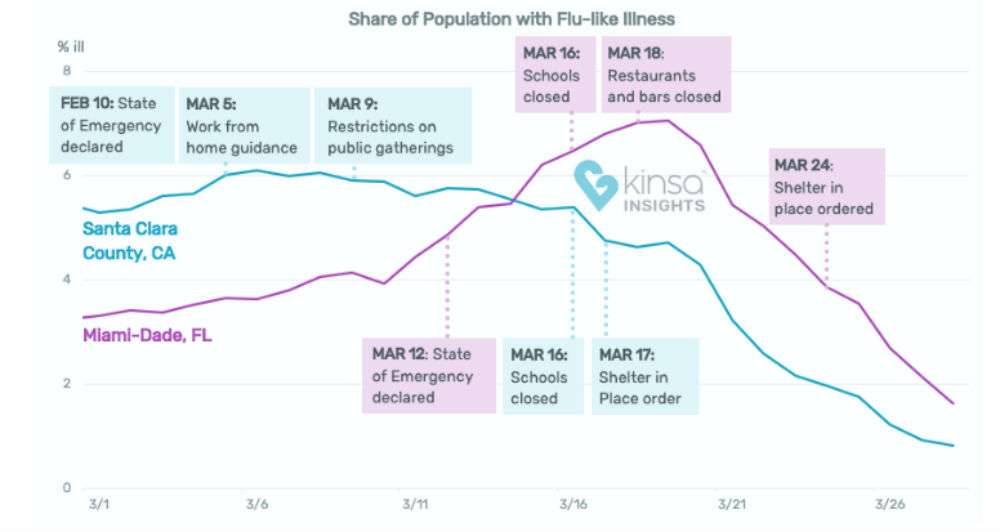U.S. Fever Trends Suggest COVID-19 Rates Could Soon Decline
"3 to 7 days after a stay-at-home order is enacted, fevers in that community start to drop."

The percentage of Americans suffering from fevers linked to influenza-like illnesses, including COVID-19, is trending strongly downward according to the U.S. Health Weather Map developed by startup Kinsa Health. The company tracks these trends using data voluntarily gathered daily from hundreds of thousands of users of its bluetooth connected thermometers. Previous data suggests that about 2.84 percent of the population should be experiencing fevers for April 5. The good news is that only 0.65 percent are running higher than normal temperatures currently.
The time series chart below compares Kinsa's observations of the influenza-like illness level in the U.S., in orange and red, against where that level was expected to be, in blue. You can see how that relationship has changed over the past few weeks.

Based on the data collected by his company, Kinsa founder and CEO Inder Singh argues that social distancing is working. "Keep staying home. You are saving lives," he writes. "Data from more than 1 million Kinsa thermometers tells the same story across the country: 3 to 7 days after a stay-at-home or shelter-in-place order is enacted, fevers in that community start to drop." The chart below shows how the differences in timing of social distancing policies in Santa Clara and Miami have affected fever trends in those jurisdictions.

COVID-19 cases and deaths are still rising because people who were unwittingly infected prior to the broader adoption of stay-at-home measures are now becoming symptomatic. If social distancing continues to be maintained, Singh expects diagnosed COVID-19 cases and deaths to peak and begin falling soon. "We are infecting each other less today than we were two weeks ago," he writes, "and this alone could save hundreds of thousands of lives."
A bonus is that social distancing policies are reducing not only novel coronavirus infections, but also those of other respiratory illnesses, including seasonal influenza and regular colds.
Already brewing in the background is the inevitable debate over whether social distancing and stay-at-home measures were actually necessary to blunt this pandemic. The main problem is that we don't live in the counterfactual world in which we did not go into lockdown. Proponents of social distancing will argue that such policies are the reason why hundreds of thousands did not die in the pandemic. Critics will point to the lower death and hospitalization rates as evidence against unwarranted alarmism. Looking at how the pandemic ultimately plays out in poorer countries with fragile health care systems, as well as in places where impoverished people can't effectively socially distance themselves, may sadly help adjudicate that dispute.
Editor's Note: As of February 29, 2024, commenting privileges on reason.com posts are limited to Reason Plus subscribers. Past commenters are grandfathered in for a temporary period. Subscribe here to preserve your ability to comment. Your Reason Plus subscription also gives you an ad-free version of reason.com, along with full access to the digital edition and archives of Reason magazine. We request that comments be civil and on-topic. We do not moderate or assume any responsibility for comments, which are owned by the readers who post them. Comments do not represent the views of reason.com or Reason Foundation. We reserve the right to delete any comment and ban commenters for any reason at any time. Comments may only be edited within 5 minutes of posting. Report abuses.
Please to post comments




I don't think it's socially acceptable to post promising news.
Good news must keep a 6 month distance
The media were liars before thus hysterical fiction. Of course they are liars now too.
Previous data suggests that about 2.84 percent of the population should be experiencing fevers for April 5. The good news is that only 0.65 percent are running higher than normal temperatures currently.
"Our previous predictions accounting for the same social distancing measures were wildly off, so we're going to claim that they worked better than expected, but still stay home for an indeterminate amount of time, peasants, until you learn to love your government masters for saving your lives."
Thinking about what could be causing the divergence between current fever trends compared to previous fever trends is pretty interesting though.
Especially if we had a baseline from which to measure. Like last year's data.
I don't think it surprises many people that fewer people are sick with flu-like symptoms as we move into spring months.
Kinsa is comparing current spring fever rate with the average for the past five years.
Thinking about what could be causing the divergence between current fever trends compared to previous fever trends is pretty interesting though.
Like maybe this thing isn't the deadly plague it's been hyped up to be?
That's the "get out of jail free" card. Assume we could "prove" the amount of lives saved, based on that report stating 2.2 million people would die if nothing was done. Ohio's share of that (rounding up for easier numbers) would be 80,000. Subtract the 60% of deaths for those aged 70+ (I think that's the rate I heard in Mr. Bailey's podcast from 3/31; so far in Ohio, the actual % of deaths in that age group is north of 72% and those over 80 account for over 47% of the deaths) and that leaves you with 32,000 "working" lives saved.
Last week's unemployment claims in Ohio topped 272,000 (up from 187,000 the week prior and 7,000 the week before that). At this point, it would seem that for every working life saved, there are about nine people forced out of work (and that number will continue to grow).
It seems to me that a better balance could be struck between keeping able-bodied people at work, while taking precautions to mitigate the damage to the vulnerable population. And, in my humble (perhaps heartless) opinion, we should probably skew towards keeping the economy running as opposed to keeping nursing homes at full capacity.
NYC is down 75% is new admissions over the last few days. Cuomo almost looks sad about it.
https://imgur.com/9fJRLRV
He also raised the fine for not socially distancing from $500 to $1,000. For the children.
Actually, I think it is to replace the collapsing sales tax revenue since someone shut down retail completely.
One of my friends on FB was joking about that. Sadly, we know what comes next: federal bailout. And I'm sure we'll end up funding those fucking pensions that caused their budget holes in the first place. I sure am enjoying my 30-day free trial of socialism!
I sure am enjoying my 30-day free trial of socialism!
Unfortunately after the 30 day trial period is over, you have to manually opt out and they reserve the right to continue to charge you for it anyway in perpetuity.
No problem, I'm sure there are plenty of government agents who will help me with this process!
.......
I keep getting a busy signal, but I'm sure it'll all work out !
Actually, you may have to shoot your way out.
And note that while you, dear taxpayer, were furloughed and still have to pay tax on your baby milk, Johny DMV, and the secretary at your local public elementary damn sure got their paychecks, all while sitting on the couch.
Stay home and visit casualencounters for relaxing yourself
I wonder how much self-selection has biased those thermometer readings. A quick look on Amazon shows prices around $100, plus or minus. I imagine only the paranoid and hypochondriacs buy them. Do they have a choice in uploading their readings? Possibly they would only upload the abnormal readings.
Don't know any of those answers, but I wonder.
Or more so, people who have jobs that allow them to self quarantine. My wife bought one of those, and we have been working from home since early march.
OR, in the current situation, only upload normal readings.
They have a choice about TAKING the readings in the first place and/or using another device to take their temperature.
There are a LOT of statistically meaningful questions not answered here.
-In any set of Kinsa owners, how many are taking their temperature every day whether they feel sick or not?
-If half the owners who took their temperature yesterday fail to do so today, how will that impact the reported trends?
-Having a fever during this pandemic is like a scarlet letter - how many Kinsa owners might suddenly develop a newfound interest in privacy and opt to use a non IOT thermometer?
There are WAY too many possible interpretations of this data for it to be meaningful. It reminds me of a dental insurance company i encountered at a software conference (they were recruiting developers) that gives clients a bluetooth-connected toothbrush to monitor their brushing habits to get a discount. I confirmed with them that only reports that the toothbrush is running. There's no way to tell if it's actually in your mouth, or scrubbing your tile grout.
Yeah, and the fact that every single location in the country gives at least some data is difficult to believe. If in fact all of this data is actually that which is being reported through these "smart" thermometers. I have no doubt that in a lot of urban areas, there are enough of these out there and enough people using them that there is some validity to the data. People in Manhattan and Silicon Valley would eat this stuff up. But I have a hard time believing that ANY of these are sold in Rosebud County, MT, much less enough of them (being used frequently enough) to give any sort of statistically relevant data for that county.
But a lot of places who meet that description are places that not as many people from outside their countries travel to/ from or import a lot of goods, which means they're more isolated from the rest of the world and therefore not as likely to experience as severe an epidemic, correct? Or so I would think.
At the very least I would think third world countries would have an even harder time collecting accurate data on number of infections and deaths than we've had which would make any data coming from them unreliable.
The sad reality is that a lot of these places won't get hit hard because they don't have old people, or fat people. This virus hits the richest countries worst because we're the only ones with a standard of living that allows widespread old age.
Might not be as isolated as you think, with many residents who are "guest workers" in more cosmopolitan countries--and who may have already been sent home.
Mr Bailey,
Graphs like the one provided by Kinsa tell me a very different story. First, when a company with country wide data decides to graph only two regions together, my Cherry Picker Alarms go off. Indeed what we see is that the Santa Clara cases had already peaked and were already headed down when the full lockdown occurred...certainly the slope changed after that.
The story I see between the two lines is that if the public practices voluntary social distancing and the city moves to limit large events during an outbreak, it is enough to "Flatten the Curve" immensely. That is the difference between SC and Miami-Dade. These graphs should be compared to relevant projections at the time.
It’s one example - check out the links to Kinsa’s data and comparisons for more details.
I got a fever. And the only prescription is...
this link was absolutely. necessary.
So is this one.
These are interesting infographics. It certainly seems to imply a recent downward trend, despite recent peaks in some hot-spot areas like NY and Florida. And the county-by-county data is certainly nice to have available.
I think I would like a little bit more background data, though. I didn't see if or where they had numbers on how many users they have in each statistical area, what percentage of the population that represents, or how often those people are using their product.
For instance, I have a decidedly non-smart, but digital, thermometer, and for the past several weeks I have been checking my temperature once or twice daily, even though I physically feel fine. In the past few months before that, I might have only checked once or twice in total, and only if I felt ill in some way.
Could that not have an effect on their numbers and they are trending? If a lot more otherwise healthy people are using their product to monitor themselves than normally would be doing so, that could have the effect of driving those numbers down. Especially since they give most of their data as a percentage.
Realistically, this data is showing that people who buy $100 thermometers might be smart enough to listen to advice regarding physical distancing. And we do have control information - communities were few people have that kind of money and the graphs are still rising. Or communities where authorities refuse to listen to epidemiologists, thinking they're part of the Deep State.
I am dubious of this so-called report for many of the same reasons. You have a self-selected body of people who - because of the purchase - likely share a wide range of economic, social, and demographic characteristics. Moreover, their behavior is highly likely to have changed this year based on COVID concerns and the lockdown orders. It just cannot be taken seriously.
Good raw data, 100% facts, 0% whining.
More good data is the U. S. case count wiki page.
It's not been easy with me here. We never had any support from the government and we are forced to stay at home. Hope this ends soon. website for Nigeria free mp3 download
100% Hysteria.
Already brewing in the background is the inevitable debate over whether social distancing and stay-at-home measures were actually necessary to blunt this pandemic. The main problem is that we don't live in the counterfactual world in which we did not go into lockdown.
Well, we can take a look at what's happening in Sweden. They did not go into lockdown. Remains to be seen if they'll continue their laissez-faire policy, but so far they seem determined to do so.